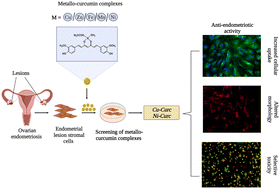Transition metallo-curcumin complexes: a new hope for endometriosis?†
Abstract
Endometriosis is a debilitating gynecological disorder in women of reproductive age. Laparoscopy, a minimally invasive surgical procedure, provides a definitive diagnosis of the disease. Current treatments, including hormonal therapy and pain medication, are often associated with undesirable side effects limiting their long-term usage. This calls for exploring newer diagnostic and therapeutic options with minimal side effects. Curcumin is an established anti-endometriotic agent with inherent fluorescent properties; however, poor bioavailability limits its clinical utility. To address this shortcoming, various transition metals were conjugated with curcumin to improve its stability, specificity and pharmacological properties. The chemical stability, hemocompatibility and ability of the synthesized metallo-curcumin complexes (MCCs) to ameliorate endometriotic lesions were investigated. While all of the MCCs exhibited low hemolytic activity, their chemical and biological activities were largely dependent on the nature of the metal ion conjugated to the curcumin molecule. Copper–curcumin and nickel–curcumin complexes demonstrated superior therapeutic efficacy evidenced by enhanced antioxidant activity, selective cytotoxicity and increased accumulation in endometriotic cells mediated by an energy-dependent active transport process.

- This article is part of the themed collections: Celebrating International Women’s Day: Women in Materials Science, 10th Anniversary: Dedicated Authors and 10th Anniversary: Most popular articles


 Please wait while we load your content...
Please wait while we load your content...